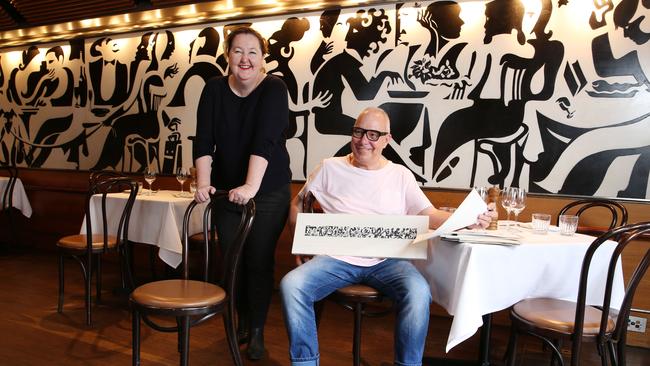‘An essence you can’t bottle’ at the Powerhouse Museum’s Australian Culinary Archive
Sifting through their personal archives in the climate of COVID-19 has brought some of the nation’s leading chefs to tears.

Sifting through their personal archives in the climate of COVID-19 has brought some of the nation’s leading chefs to tears as they reflect on their achievements and disappointments in an industry currently on its knees.
Collating objects to feature in the Powerhouse Museum’s Australian Culinary Archive, a vault to preserve the nation’s food heritage, the chefs gave handwritten recipes, notes and menus they had gathered for decades.
Damien Pignolet, former executive chef of Bistro Moncur in Woollahra in Sydney’s inner east, said looking over the original notes he took more than 30 years ago caused him to feel an unexpected level of emotion.
“It was fascinating, fleshing out the beginnings of what I used to write about, it was so emotional. I completely lost it,” he said.
“There hasn’t been one person who hasn’t lost it. It’s our craft and there is so much history and emotion. There should be an emotional reaction.’’
The collection will also delve into the treasure troves of Kylie Kwong, Peter Gilmore, Ben Shewry, Neil Perry, Guy Grossi, Andrew McConnell and John Susman.
The museum will include contributions from producers spanning 50 years, with Janni Kyritsis’ 1968 copy of The Margaret Fulton Cookbook marking the starting point of the archive. The book, a gift from his partner David, is responsible for teaching the chef how to cook and to speak English. It is now held together by electrical tape and is the centrepiece of the collection.
Original sketches of Peter Gilmore’s Snow Egg dessert, from the notebook he began in 2005, will be among pieces of furniture taken from Australia’s most beloved eateries, such as a chair from Neil Perry’s Rockpool Bar & Grill, which opened in 1989.
Handwritten menus and wine lists from Bistro Moncur in 1993 will feature, plus ceramics and kitchenware Fulton used in her books and cooking shows. A lantern and sign from designer Chen Liu from Billy Kwong has been sourced, with copies of Gourmet Traveller from the 1980s.
Publisher Julie Gibbs, who is leading the project for the museum and has done more than 40 interviews with chefs, said passion fuelled their emotion.
“People who work in this industry are driven by this essence you can’t bottle. They’re driven by passion, ambition, drive and adrenaline, and their work means everything to them,” Gibbs said. “When you’re talking to them about their lives, they have to dig deep and really deal with what has mattered to them about their career.”
Powerhouse Museum chief executive Lisa Havilah said the project would document the history of Australia’s food scene and would be a foundational resource for culinary apprentices.
“It’s a project that will never end and it will continue to unfold over time,” Ms Halivah said. “We want to build it as a resource for young chefs coming up through the industry to be able to connect with its incredible history.
“By establishing this archive … (we are) ensuring that the histories and stories, and innovation that restaurateurs do every day, are protected and shared for generations to come.”




To join the conversation, please log in. Don't have an account? Register
Join the conversation, you are commenting as Logout